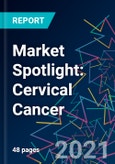This Market Spotlight report covers the Cervical Cancer market, comprising key marketed and pipeline drugs, recent events and analyst opinion, clinical trials, upcoming and regulatory events, probability of success, licensing and acquisition deals, and a 10-year disease incidence forecast, as well as presenting drug-specific revenue forecasts.
Key Takeaways
Key Takeaways
- The publisher estimates that in 2017, there were 564,900 incident cases of cervical cancer in females worldwide, and expects that number to increase to 618,400 incident cases by 2026.
- Approved drugs for cervical cancer target vascular endothelial growth factor, topoisomerase I, programmed death-1 receptor (PD-1)/programmed death ligands (PD-L1 and PD-L2), the immune system, and reactive oxygen species/free radicals. The majority of these therapies are administered via the intravenous route.
- The majority of the industry-sponsored drugs in active clinical development for cervical cancer are in Phase II, with three drugs in the NDA/BLA stage.
- Therapies in development for cervical cancer focus on a wide variety of targets. The majority of the pipeline drugs are administered via the intravenous route, with the remainder being oral, subcutaneous, intramuscular, intravesical, and intranasal formulations.
- High-impact upcoming events for drugs in the cervical cancer space comprise topline Phase III trial results for Libtayo and Imfinzi, and expected PDUFA dates for biosimilar bevacizumab (Mylan/Biocon) and tisotumab vedotin.
- The overall likelihood of approval of a Phase I solid tumors asset is 5.4%, and the average probability a drug advances from Phase III is 43%. Drugs, on average, take 9.7 years from Phase I to approval, compared to 9.6 years in the overall oncology space.
- The distribution of clinical trials across Phase I–IV indicates that the vast majority of trials for cervical cancer have been in the early and mid-phases of development, with 94% of trials in Phase I–II, and only 6% in Phase III–IV.
- The US has a substantial lead in the number of cervical cancer clinical trials globally. The UK leads the major European markets, while China has the top spot in Asia.
- Roche has the highest number of completed clinical trials for cervical cancer, with 16 trials.
- AstraZeneca leads industry sponsors with the highest overall number of clinical trials for cervical cancer.
Table of Contents
OVERVIEWKEY TAKEAWAYSDISEASE BACKGROUNDEPIDEMIOLOGYMARKETED DRUGSPIPELINE DRUGSKEY UPCOMING EVENTSPROBABILITY OF SUCCESSREVENUE OPPORTUNITYAPPENDIX
TREATMENT
RECENT EVENTS AND ANALYST OPINION
KEY REGULATORY EVENTS
LICENSING AND ASSET ACQUISITION DEALS
CLINICAL TRIAL LANDSCAPE
BIBLIOGRAPHY
LIST OF FIGURES
LIST OF TABLES








